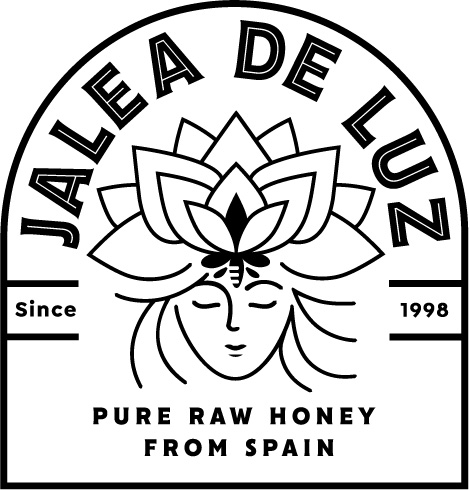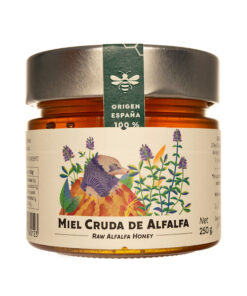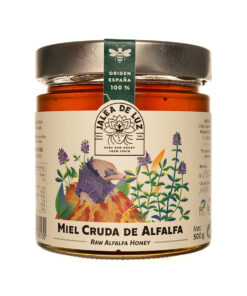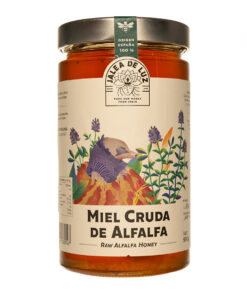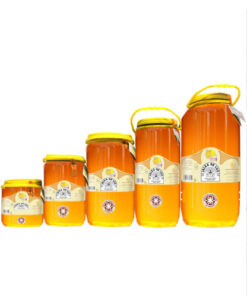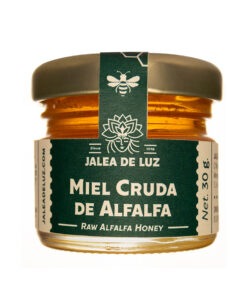Lucerne Honey
Origin: Spain and other areas of the Iberian Peninsula.Representative species: Lucerne (Medicago sativa L.)
Main Floral composition: Lucerne (Medicago sativa L.) and varied native wild Flora.
production time: spring - summer.
Color: light amber, sometimes vivid and sometimes yellowish ochre in others.
taste: sweet, soft and harmonious.
Aroma: pleasant, warm, subtle and light.
Peculiarities: raw honey, pure, not homogenized, not filtered, without added sugars.
Conservation: keep in a dry, semi-dark and cool place.
** In its natural process, honey crystallizes and hardens according to various parameters (temperature, floral origin, etc..).
Characteristics of Lucerne honey
Honey of beautiful light amber color, even vivid when predominantly Lucerne, tending towards soft ochre tones somewhat darker, even amber-yellow intense sometimes, if mixed with other spontaneous coetaneous flowers that have libated bees.Its aroma is pleasant, warm, subtle and light, according to a delicate sweet taste, soft and harmonious reminiscent in lontananza, saving the inevitable distances, to the gentle flower of orange blossom It is very complete in diversity of minerals (calcium, phosphorus, iron, potassium,..) and S vitamins (A, C, D, E, B6, B12, K), resulting in a good food supplement very useful at certain times.
Crystallizes in fine crystals creating a pleasant texture to the palate.
Excellencies of Lucerne honey
Like our entire range of honeys and Hive derivatives (royal jelly, pollen, propolis,..), we talk about a pure handmade Lucerne honey collected by our bees in natural minifundios selected orchards, which has a set of incredible qualities and meets all the requirements to be a natural product excelso:* Raw: has not been subjected to overheating processes (more than 40 degrees) or pasteurization. It has a wide range of vitamins, nutrients and enzymes, also preserving its taste and olfactory qualities of origin.
* Pure: the bees release pollen and nectar from the flowers, and secretions of sucking plants and insects that carry inside the hive, then proceed to its transformation and storage in the form of pure honey in the honeycomb cells; that is why in this process there are no external factors that nature itself provides.
* Non-homogenized: we never mix natural honeydew from different geographical or floral sources. Our aim is always to maintain the essence and purity of all our products.
* Unfiltered: we never filter it, because in this way we keep all the natural qualities intact, thus achieving an excellent natural product of supreme quality.
* No added sugars: our honey has only natural sugars typical of an unadulterated natural product, remaining as the bee produces in the hive.
Usage tips
The natural Lucerne honeys collected by our bees have unique qualities, being highly advisable to take them directly, tasting them inside the mouth as long as possible before ingesting them. To make them more manageable in those cases that are preferred diluted, it is recommended at most, warm the "bain-marie" to temperature that never exceeds 40 º to avoid the loss of natural attributes.Conservation tips
Keep in a dry, semi-dark and cool place to keep intact in a natural way all its natural qualities.Where does it come from?
This exquisite natural handcrafted honey of vivid color, is produced by bees as a result of libation to extract pollen and nectar from the flowers of Lucerne (Medicago sativa L.) and the varied native wild flora of the environment.Lucerne plants are perennial herbaceous species, upright or semi-upright (about 40 to 60 cm tall), slightly pivoting Root bearing nodules inhabited by nitrogen-fixing bacteria, hairy stems, trifoliate Composite leaves, flowers grouped in inflorescences in the form of pedunculated clusters whose Corolla is violaceous and leguminous.
It is a plant for forage use although we can locate it naturally in the margin of roads, crops, etc..
Lucerne honey, etymology and History
The scientific name "Medicago" originated in the Italian region of Medea. There are other versions in which reference is made to the Medes ' grass, an Iranian people who introduced its cultivation during the first millennium in the area of present-day Iraq.As for the common name, Lucerne had its birthplace in Persia (it was called "aspa - Asti" (horse - food = what the horse eats)) , where already in the Bronze Age began its use to feed horses and some kind of cattle, in fact it was one of the first plants cultivated by the human being. It is claimed that it was introduced there, by horses of Asian origin that the humans carried along with the food that they grazed. Previously there is the Assyrian word " aspastu "and other relative in the Aramaic, then passing to the Arabic" Alfasasat "or" Al-fac-facah", which means" mother of all food", to be refined in the Hispania of Al-Andalus until reaching the name we currently know.
In ancient Greek texts, Pliny The Elder (Latin naturalist among other things) narrates his introduction in Greece towards 490 BC , citing in addition to his livestock use, his employment in the culinary arts (ingesting in the form of tender shoots in salads and in many traditional recipes based on local foods); he describes it as an exotic plant of very long-lived seeds, which requires dense sowing and several annual cuts made before the issuance of flowers.
The tender leaves of Lucerne were already used by sages of ancient China and India, due to their excellent natural qualities. Native Indian cultures of North America, used it together with other aromatic species to enhance their qualities at certain times. In ancient texts the germ of Lucerne was widely used as a natural complement.
Lucerne honey recipes
Lucerne honey salad dressingIt is a very simple and effective recipe for dressing salads, fresh pasta, etc.., being able to keep it in the refrigerator hermetically closed in a glass container, stirring well before serving. We have an electric mixer and add 5 tablespoons of olive oil pressed in cold, 2 tablespoons of honey, Lucerne, yellow in color is always more soft on the palate, a single drop of heather honey, orange blossom, eucalyptus and forest mixed together to give the counterpoint , 2 tablespoons squeezed lemon juice, a pinch of sea salt, 1 clove of garlic previously crushed, a pinch of aromatic herbs crushed as thyme and rosemary, and a few drops of apple cider vinegar pure.
Whisk the food well until homogenized and ready !!!!!!!
We already have a rich sauce fresh, soft, pleasant and peculiar flavor, which will give amazing color to our dishes!!!!
Also noteworthy is its versatility to mix in infusions as a flavor enhancer and natural qualities.
